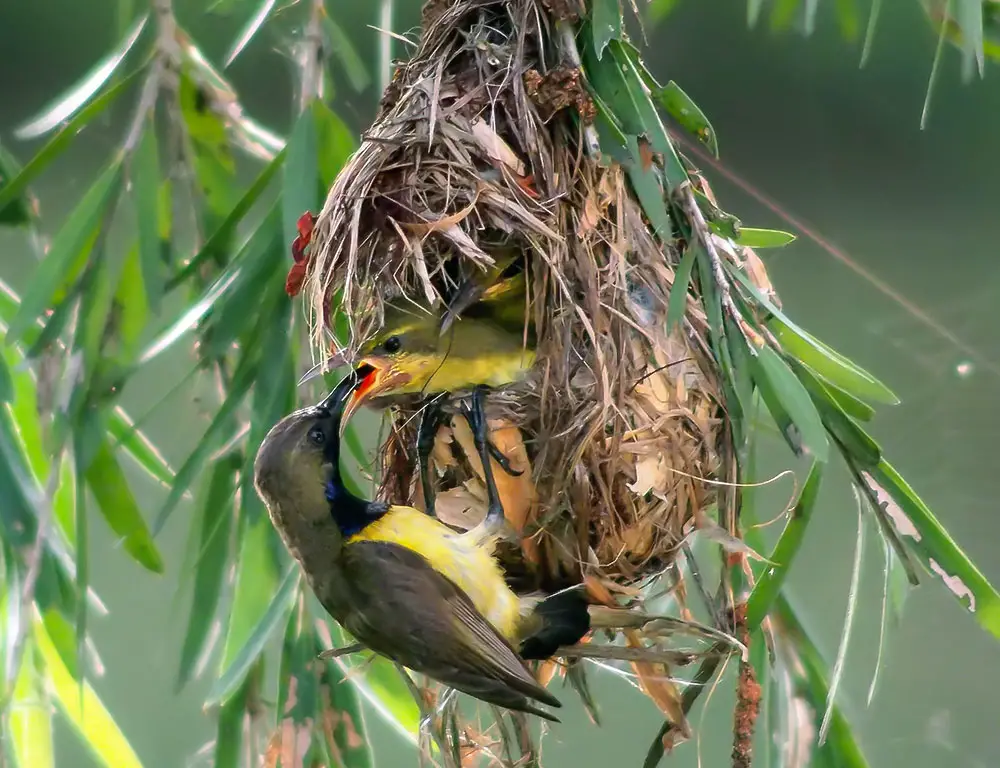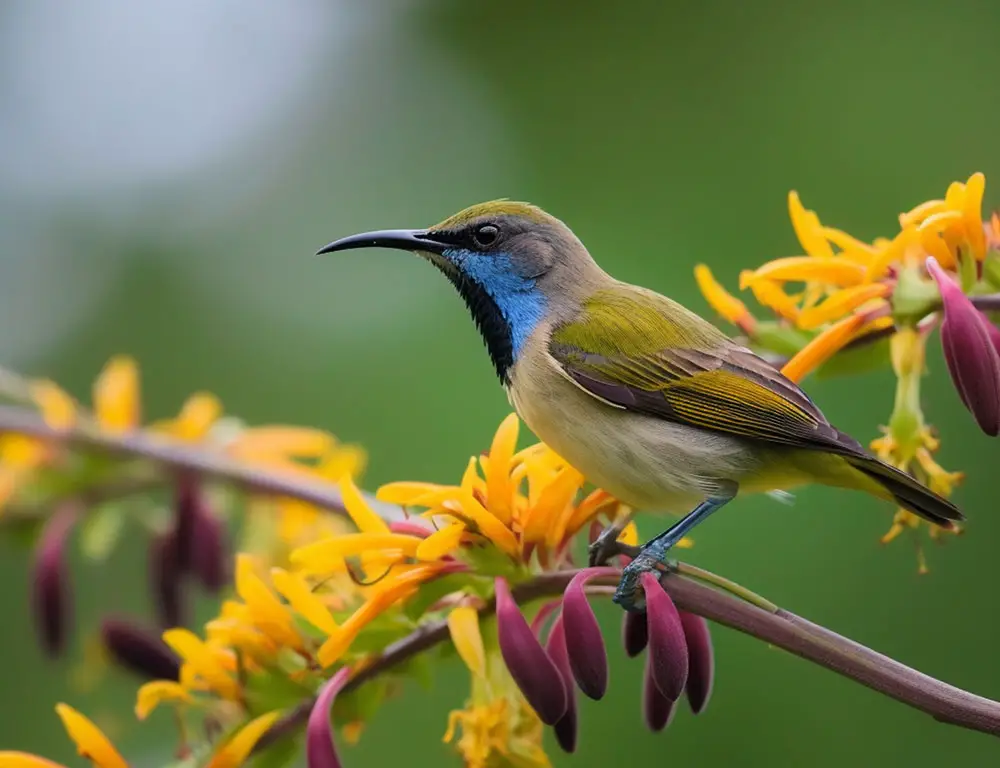There’s a certain charm to the Olive-Backed Sunbird, an enchanting little creature that adds a splash of color and vibrancy wherever it goes.
Native to the tropical regions of Southeast Asia, this bird is a sight for sore eyes with its brilliant plumage – deep olive-green on its back and bright yellow on its underparts.
An exciting aspect of this species is its adaptability. They’re just as comfortable in human-dominated landscapes as in thick forests or mangroves.
From city parks and gardens to coastal regions, you’ll find these birds making themselves very much at home.
A distinguishing trait of the Olive-Backed Sunbird is their unique feeding habits. These nectar-loving birds have long curved beaks designed specifically for sipping nectar from flowers.
But don’t let that fool you! They’re not strictly vegetarians – they also snack on small insects when given the chance, making them opportunistic feeders.

Physical Characteristics of the Olive-Backed Sunbird
The Olive-Backed Sunbird (Cinnyris jugularis) possesses several distinctive physical characteristics that contribute to its unique appearance and behavior. Here’s an overview:
Size
Olive-backed sunbirds are small birds, measuring approximately 10 to 12 centimeters (4 to 4.7 inches) in length from beak to tail. They belong to the group of birds known as passerines or perching birds.
Plumage
The plumage of Olive-Backed Sunbirds varies between males and females. Males exhibit striking metallic blue throats and chests, contrasting with olive-green backs. They often have iridescent feathers that shimmer in the sunlight.
In contrast, females have more subdued plumage, typically featuring shades of brown and gray. Both sexes may display a yellow or orange patch on their belly.
Bill
Olive-backed sunbirds have long, slender, and slightly curved bills, which are well-adapted for probing deep into flowers to extract nectar. The bill shape also facilitates catching small insects and spiders, supplementing their diet.
Wings

Their wings are pointed rather than rounded, which aids in maneuverability and agility, particularly when navigating through dense vegetation or during their distinctive hovering feeding behavior.
Tail
Olive-backed sunbirds have relatively short tails compared to their body size. While the tail may not be as long as some other bird species, it is still essential to their aerial maneuvering and balance.
Sexual Dimorphism
Like many bird species, Olive-Backed Sunbirds exhibit sexual dimorphism, with males and females displaying different plumage characteristics. This dimorphism helps distinguish between the sexes, particularly during the breeding season.
Habitat and Distribution of the Olive-Backed Sunbird
The Olive-Backed Sunbird (Cinnyris jugularis) is native to Southeast Asia’s tropical and subtropical regions and parts of Australasia. Here’s an overview of its habitat and distribution:
Habitat
Olive-Backed Sunbirds are highly adaptable birds that can thrive in various habitats, ranging from primary and secondary forests to urban areas, gardens, parks, and even coconut plantations.
They are commonly found in areas with dense vegetation, particularly those with flowering plants that provide a source of nectar for their diet.
Geographic Distribution

Olive-Backed Sunbirds have a wide geographic range across Southeast Asia and Australasia. They are found in Thailand, Malaysia, Indonesia, the Philippines, Papua New Guinea, and northern Australia.
Additionally, they have been introduced to some Pacific islands, including Fiji, Samoa, and Hawaii.
Urban Habitats
One exciting aspect of Olive-Backed Sunbirds is their ability to adapt to urban environments. They are frequently observed in city parks, gardens, and roadside trees, where they take advantage of flowering plants for food and nesting sites.
This adaptability to human-modified landscapes has allowed them to thrive despite habitat loss in some regions.
Nectar-Rich Environments
While Olive-backed Sunbirds can inhabit various habitats, they are particularly associated with areas rich in nectar-producing flowers. Their diet primarily consists of nectar, which they obtain by probing deep into flowers with slender, curved bills.
Therefore, they are often found in areas with diverse flowering plants, including native species and introduced ornamental plants.
Behavior and Diet of Olive-Backed Sunbirds
The behavior and diet of the Olive-Backed Sunbird (Cinnyris jugularis) are fascinating aspects of its ecology. Here’s an overview:
Feeding Habits

- Nectar Feeding: Olive-backed Sunbirds are primarily nectar feeders. They have specialized long, slender bills adapted for probing deep into flowers to extract nectar.
They play a crucial role in pollination as they visit flowers, searching for this sweet liquid. Their diet includes a variety of flowering plants, including native species and introduced ornamental plants. - Insectivorous Diet: While nectar forms the bulk of their diet, Olive-Backed Sunbirds supplement their nutrition with tiny insects, spiders, and other invertebrates. They may catch these prey items while foraging in vegetation or during aerial pursuits.
Foraging Behavior
- Hover-Feeding: One of the most distinctive behaviors of Olive-Backed Sunbirds is their ability to hover in front of flowers while feeding.
This acrobatic maneuver allows them to access nectar from flowers that may be too fragile to support their weight or positioned in difficult-to-reach locations. - Perching and Probing: In addition to hovering, Olive-Backed Sunbirds also perch on flowers or nearby branches while feeding. They use their specialized bills to probe the base of flowers, where nectar is often concentrated and may defend feeding territories against intruding individuals.
Breeding Behavior
- Nest Construction: Olive-backed Sunbirds are cooperative breeders, with both males and females participating in nest construction.
They build intricate hanging nests using plant materials such as grass, leaves, and spider webs. These nests are often suspended from the branches of trees or shrubs. - Incubation and Parental Care: After nest construction, females lay one or two eggs, which both parents then incubate. Once the eggs hatch, both parents feed the chicks with nectar and insects until they fledge and become independent.
Vocalizations
Olive-backed sunbirds are known for their musical and varied vocalizations. Males may sing to establish territories or attract mates, while males and females may use calls to communicate with their offspring or other social group members.
Conservation Status of Olive-Backed Sunbirds

The Olive-Backed Sunbird (Cinnyris jugularis) is currently classified as “Least Concern” by the International Union for Conservation of Nature (IUCN).
While this designation indicates that the species is not facing immediate threats of extinction, it’s essential to recognize ongoing conservation challenges and the need for continued monitoring and protection efforts.
Here’s a closer look at the conservation status of Olive-Backed Sunbirds:
Habitat Threats
The primary threats to Olive-Backed Sunbirds include habitat loss and degradation due to human activities such as deforestation, urbanization, and agricultural expansion.
These processes can destroy their natural habitats, including forests and gardens, and reduce the availability of suitable nesting sites and food resources.
Adaptability
Olive-backed sunbirds have shown remarkable adaptability to urban environments, successfully nesting and breeding in cities’ gardens, parks, and other green spaces.
This adaptability allows them to persist in human-modified landscapes despite habitat loss in natural habitats.
Population Trends
While no significant population declines are reported for Olive-Backed Sunbirds, ongoing monitoring is necessary to ensure that populations remain stable over time. Changes in habitat quality and availability, as well as other environmental factors, could impact population trends in the future.
Conservation Efforts
- Continued Monitoring: Conservation efforts for Olive-Backed Sunbirds should include continued monitoring of population trends, habitat status, and potential threats. Long-term data collection is essential for assessing the effectiveness of conservation measures and informing management decisions.
- Habitat Protection: Protecting and restoring habitats, including forests, gardens, and urban green spaces, is crucial for conserving Olive-Backed Sunbirds. Efforts to conserve biodiversity in these areas can benefit this species and other wildlife.
- Education and Awareness: Raising awareness about the importance of biodiversity conservation and the role of Olive-Backed Sunbirds in ecosystems can help garner support for conservation initiatives. Engaging local communities, policymakers, and stakeholders is essential for promoting sustainable practices and habitat conservation.
Conclusion
The Olive-Backed Sunbird is a captivating symbol of nature’s vibrancy, with its iridescent plumage and melodious song. This tiny bird thrives in tropical environments rich in nectar-bearing flora, favoring dense vegetation for nesting.
Despite facing habitat challenges due to urbanization, the species has displayed remarkable adaptability, often seen in city gardens and parklands.
However, it’s crucial not to take their presence for granted, as conservation efforts are needed to ensure their continued survival.
With a lifespan of up to 8 years in the wild and breeding seasons varying by location, Olive-Backed Sunbirds offer endless opportunities for observation and appreciation.
Let’s embrace the enchantment of these beautiful creatures and strive to protect their habitats for generations to come.